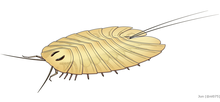Cheloniellida
| Cheloniellida Temporal range:
| |
|---|---|

| |
| Restoration of Cheloniellon | |
| Scientific classification | |
| Domain: | Eukaryota |
| Kingdom: | Animalia |
| Phylum: | Arthropoda |
| (unranked): | †Artiopoda |
| (unranked): | † Vicissicaudata
|
| (unranked): | †Cheloniellida Broili, 1932 |
| Genera | |
| |
Cheloniellida is a taxon (usually referred to as an order
Morphology

The flattened, ovoid body of cheloniellid comprises an
Based on available materials, the cephalon comprises a pair of antennae and 5 pairs of uniramus appendages, with the posterior 4 pairs bore gnathobases.[6] There are evidences that the non-gnathobasic second cephalic appendages are specialized or even raptorial in some species.[6][2] Each of the trunk segments (except the last one) has a pair of biramous appendages each consisting of a leg-like endopod and a shorter exopod.[2] The last trunk segment has a pair of spine/whip-like appendages referred as furcae[3] or cerci,[6] some species bore a medial spine between it which may or may not be a telson.[2]
Classification
Phylogenetic position
While Boudreaux (1979) regarded Cheloniellida as a class, evidences (suggests that chelicerae are in fact deutocerebral).
| ||||||||||||||||||||||||||||||||||||||||||||||||||||||
| Summarized phylogeny of Artiopoda with focus on Cheloniellida, based on Lerosey-Aubril et al. (2017).[4] |
As of 21st century, Cheloniellida was mostly found to form a clade with
Included genera and species
The unambiguous members of cheloniellids shown as follows:
- Cheloniellon Broili, 1932
- Cheloniellon calmani Broili, 1932—Lower Devonian, Germany
- Duslia Jahn, 1893
- Duslia insignis Jahn, 1893—Upper Ordovician, Czech Republic, Morocco
- Eoduslia Van Roy, 2006 (unpublished?)
- Eoduslia brahimtahiri Van Roy, 2006—Upper Ordovician, Morocco (unpublished?)
- Neostrabops Caster & Macke, 1952
- Neostrabops martini Caster & Macke, 1952—Upper Ordovician, United States
- Paraduslia Dunlop, 2002
- Paraduslia talimaae Dunlop, 2002—Lower Devonian, Russia
- Pseudarthron Selden & White, 1984
- Pseudarthron whittingtoni Selden & White, 1984—Upper Silurian
- Triopus Barrande, 1872
- Triopus drabowiensis Barrande, 1872—Upper Ordovician, Czech Republic, Morocco
In 2018, a new species (informally named "
References
- ^ OCLC 38305908.
- ^ a b c d e f g h i j k l m n Wendruff, Andrew James, et al. "New cheloniellid arthropod with large raptorial appendages from the Silurian of Wisconsin, USA." BioRxiv (2018): 407379. [1]
- ^ S2CID 85744103.
- ^ PMID 28894246.
- S2CID 89985331.
- ^ S2CID 87725308.
- ^ a b c STfJRMER, W. t~ BERGSTROM, J. 1981. Weinbergina, a xiphosuran arthropod from the Devonian Hunsriick Slate. - Palaontologische Zeitschrift 55: 237-255.[2] Archived 2020-06-20 at the Wayback Machine
- ^ Boudreaux H. B., 1979. Significance of intersegmental tendon system in arthropod phylogeny and monophyletic classification of Arthropoda. pp. 551-586. In.: Gupta A.P. [Ed.]. Arthropod Phylogeny. Van Nostrand Reinhold Company, N.Y., 1-762
- ^ Chlupác I. The enigmatic arthropod Duslia from the Ordovician of Czechoslovakia. Palaeontol. 1988; 31:611–620.[3]
- ^ BROILI, F. (1932): Ein neuer Crustacee aus dem rheinischen Unterdevon. -- Sitzungsber. bayer. Akad. Wiss.: 27--38; Miinchen.[4]
- ^ BROILI, F. (1933): Ein zweites Exemplar von Cheloniellon. -- Sitzungsber. bayer. Akad. Wiss.: 11--32; Miinchen.[5]
- ^ Delle Cave, L. and A.M. Simonetta (1991) Early Palaeozoic arthropods and problems of arthropod phylogeny; with some notes on taxa of doubtful affinities. In The Early Evolution of Metazoa and the Significance of Problematic Taxa, eds. A. M. Simonetta and S. Conway Morris. Cambridge University Press, Cambridge, England. Vol. 189–244.
- ^ Wills, M. A., Briggs, D. E. G., Fortey, R. A. & Wilkinson, M. 1995. The significance of fossils in understanding arthropod evolution. Verhandlungen der deutschen zoologischen Gesselschaft 88, 203–15.
- ISBN 978-94-011-4904-4
- PMID 9724762.
- PMID 11874919.
- S2CID 4307398.
- S2CID 833103.
- S2CID 6048195.
- S2CID 13101102.
- ISSN 1467-8039.
- S2CID 13101102.
- ISSN 0567-7920.
- ^ S2CID 15290784.
- ^ S2CID 133058010.
- PMID 24077329.
- ^ Wendruff, Andrew J. (2016). Paleobiology and Taphonomy of Exceptionally Preserved Organisms from the Brandon Bridge Formation (Silurian), Wisconsin, USA (Thesis). The Ohio State University.
- S2CID 245285654.
- S2CID 249652930.
- Boudreaux, H. Bruce (1979). Arthropod phylogeny with special reference to insects. John Wiley & Sons. ISBN 978-0471042907.
- ISBN 978-0412754203.
- Dunlop, Jason A.; Selden, Paul A. (1997). "The early history and phylogeny of the chelicerates". In ISBN 978-0412754203.
- Hou Xianguang; Bergström, Jan (2006). Arthropods of the Lower Cambrian Chengliang fauna, southwest China. Fossils & Strata Monograph Series. Wiley-Blackwell. ISBN 978-8200376934.
